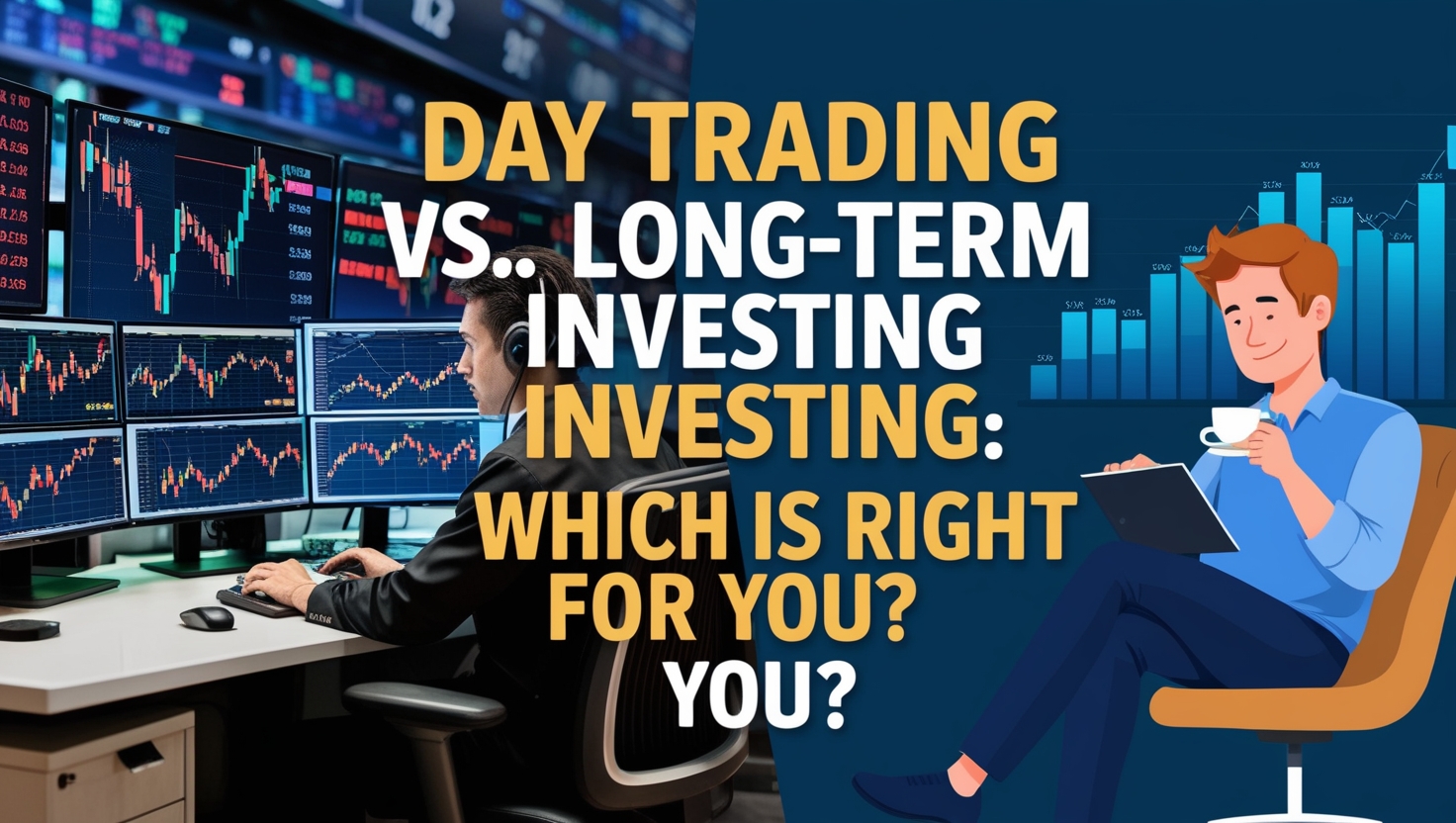
Day Trading vs. Long-Term Investing : Are you thinking about day trading or long-term investing but not sure which fits your goals? Both day trading and long-term investing are ways to invest in the stock market. Each has its own special features and needs. It’s important to know the differences to make a smart choice.
Day trading means buying and selling stocks in one day to make quick profits. Long-term investing, however, is about keeping stocks for years or even decades. It aims to weather market ups and downs and enjoy long-term growth. So, which path is best for you?
Key Takeaways
- Day trading involves buying and selling stocks within a single trading day
- Long-term investing involves holding onto stocks for an extended period
- Day trading requires a significant amount of time and attention
- Long-term investing requires a long-term perspective and patience
- Understanding your financial goals and risk tolerance is crucial to choosing between day trading and long-term investing
- Day trading and long-term investing have different requirements and characteristics
- It’s essential to educate yourself on both day trading and long-term investing before making a decision
Understanding the Basics of Trading and Investing
Stock trading strategies often confuse investors between day trading and long-term investing. Each has its own benefits and drawbacks. Knowing these differences is key to making smart choices. Your investment horizon helps decide which strategy fits your goals and risk level.
Day trading means buying and selling stocks in one day. It needs quick market analysis and fast decisions. Long-term investing, however, holds stocks for years or decades. It looks at a company’s long-term growth and financial health.
What is Day Trading?
Day trading is buying and selling stocks in a single day. It demands fast market analysis and quick decisions. Traders use technical analysis to predict short-term price changes and make money from them.
What is Long-Term Investing?
Long-term investing holds stocks for years or decades. It focuses on a company’s financial health and growth. Investors use fundamental analysis to check a company’s financials and growth chances.
| Strategy | Time Frame | Risk Level | Potential Returns |
|---|---|---|---|
| Day Trading | Short-term | High | High |
| Long-term Investing | Long-term | Low | Steady |
Time Commitment and Lifestyle Considerations
Reaching your financial goals means thinking about the time and lifestyle impact of day trading and long-term investing. Day trading needs a lot of time and focus, as traders must watch the market closely and act fast. Long-term investing, however, is more relaxed, letting you hold onto your investments for a long time and focus on other life areas.
If you’re into day trading, having a flexible schedule is key. Markets can change quickly, and traders must be ready to act fast. This can be tough for those with regular 9-to-5 jobs or other commitments. Long-term investing, however, is better for those with busy lives, as it doesn’t need constant checking and adjusting.
Important things to think about for day trading and long-term investing include:
- Time commitment: Day trading takes a lot of time, while long-term investing needs less checking.
- Lifestyle flexibility: Day trading needs a flexible schedule, while long-term investing fits better with busy lives.
- Financial goals: Both strategies can help meet financial goals, but consider the time and lifestyle impact.
The choice between day trading and long-term investing depends on your personal situation, financial aims, and lifestyle. Knowing the time and lifestyle aspects of each can help you choose what fits your needs and goals.
| Investing Strategy | Time Commitment | Lifestyle Flexibility |
|---|---|---|
| Day Trading | High | Low |
| Long-Term Investing | Low | High |
Required Capital and Resources for Each Strategy
Day trading and long-term investing both need the right capital and resources for success. Risk management is key in both, helping to avoid big losses and make the most of gains. Knowing the minimum investment needed for each is crucial.
A day trader needs a lot of capital for trading costs, like commissions and fees. Long-term investors can start with less, as they face less market volatility.
Day Trading Capital Requirements
Day traders must have enough capital for trading costs and losses. The amount needed depends on the trader’s trading psychology and risk tolerance.
Long-Term Investment Minimum Requirements
Long-term investors can start with $1,000 to $5,000. They face less market volatility, allowing them to weather market ups and downs.
Technology and Tools Needed
Both day traders and long-term investors need the right tech and tools. This includes a good computer, internet, and trading software. They also need to know market analysis well.
Understanding the capital and resource needs for each strategy helps investors choose wisely. Whether day trading or long-term investing, the right resources and mindset are essential for success.
Day Trading vs. Long-Term Investing: Which is Right for You?

Choosing between day trading vs. long-term investing depends on your financial goals and how much risk you can take. Each method has its pros and cons. Trading vs. investing needs different skills, time, and knowledge.
Think about your investment time frame. For quick goals, day trading might be better. But for building wealth over time, long-term investing is usually the way to go. It’s key to match your financial goals with the right strategy.
Here are some things to think about when choosing between day trading vs. long-term investing:
- Risk tolerance: Can you handle the ups and downs of day trading or do you prefer the steady pace of long-term investing?
- Time commitment: Do you have enough time for day trading or do you prefer a longer investment period?
- Expertise: Do you know enough about day trading or are you more comfortable with long-term investing?
The choice between day trading vs. long-term investing depends on your personal situation and goals. By considering these points and your financial goals, you can pick the best strategy for you.
It’s important to learn and keep up with market trends and analysis. This ensures you’re making the best choice for your financial goals. Whether you go for day trading or long-term investing, being informed and ready is key.
| Strategy | Risk Level | Time Commitment | Expertise Required |
|---|---|---|---|
| Day Trading | High | High | Advanced |
| Long-Term Investing | Low | Low | Basic |
Understanding Market Analysis Methods
Market analysis is key for both day trading and long-term investing. It helps people make smart choices about their money. By doing deep market analysis, traders and investors spot trends, patterns, and risks. This leads to better risk management.
Trading psychology is also important. It’s about knowing how emotions and thoughts affect our investment choices.
There are many ways to do market analysis. These include technical, fundamental, and hybrid methods. Technical analysis looks at charts and patterns to guess future prices. Fundamental analysis checks a company’s financials and industry trends for growth potential. Hybrid methods mix both to give a full view of the market.
- Identifying trends and patterns in the market
- Evaluating the financial health of companies and industries
- Assessing the impact of economic and geopolitical events on the market
- Developing a trading plan that incorporates risk management strategies
Using market analysis in your strategy helps you understand the market better. This leads to smarter trading and risk management.
Understand the risks and regulations of investing with official resources from the U.S. SEC here.
Risk Management Strategies
Effective risk management is key in day trading and long-term investing. It’s about planning to reduce losses and increase gains. A big part of this is market analysis, which helps understand trends and make smart choices.
A good risk management plan includes setting the right trade size, using stop-loss orders, and diversifying your portfolio. These steps help reduce losses and match investments with your risk level. Trading psychology is also important, as emotions can lead to bad decisions.
Some main risk management strategies are:
- Position sizing: choosing the right amount of money for each trade
- Stop-loss orders: setting a price to close a trade and limit losses
- Portfolio diversification: spreading investments to reduce risk
Using these strategies in a risk management plan helps traders and investors succeed.
Risk management is not just about minimizing losses, but also about maximizing gains. By developing a comprehensive risk management plan, traders and investors can ensure that their investments are aligned with their financial objectives and risk tolerance.
Psychological Aspects and Emotional Control
Emotional control is key in trading. It impacts trading psychology and decision-making. Managing emotions like fear and greed is crucial for success. Good risk management helps keep emotions in check.
Knowing market analysis is important for a trading plan. It helps you make smart choices and avoid emotional decisions. A solid plan lowers stress and boosts confidence, leading to better control.
To control emotions, traders can try mindfulness, set achievable goals, and follow a routine. It’s also key to stay updated on market trends and analysis. This way, you avoid emotional reactions to market changes. Focusing on long-term goals and staying disciplined can enhance trading psychology and success chances.
Some effective strategies for emotional management in trading are:
- Setting clear goals and risk tolerance
- Developing a trading plan and sticking to it
- Practicing mindfulness and self-discipline
- Staying informed about market analysis and trends
By using these strategies, traders can better manage their emotions, reduce stress, and make smarter choices. Good risk management and market analysis are also vital for a successful trading plan. They help traders handle the emotional side of the market.
Potential Returns and Realistic Expectations
When thinking about financial goals, it’s key to know the potential returns and realistic expectations of day trading and long-term investing. Both have their own good and bad sides. It’s important to set goals that are achievable to measure success.
Day trading and long-term investing are two ways to reach financial goals. Trading vs. investing needs a good understanding of the markets, managing risks, and controlling emotions. Day trading means buying and selling securities in one day. Long-term investing means keeping investments for a long time.
Day Trading Profit Potential
Day trading can be very profitable, but it’s important to have realistic hopes. A good day trader can make a lot of money, but it’s key to manage risks and avoid big losses.
Long-Term Investment Returns
Long-term investing, however, can give more stable returns over time. Historically, long-term investments have done better than day trading. But, it’s important to be patient and disciplined in your investment approach.
To succeed in day trading or long-term investing, setting realistic goals and expectations is crucial. By knowing the potential returns and risks of each strategy, you can make smart choices. This helps you create a plan that fits your financial goals.
| Strategy | Potential Returns | Risk Level |
|---|---|---|
| Day Trading | High | High |
| Long-Term Investing | Stable | Low-Moderate |
Tax Implications and Legal Considerations
Understanding taxes and laws is key when you’re into day trading and long-term investing. Both have their own tax rules. Knowing these helps you reach your financial goals without trouble.
Day trading taxes apply to each trade. The more trades you make, the more taxes you’ll pay. But, long-term investing gets better tax treatment. Long-term gains are taxed less.
Important things to think about for day trading and long-term investing include:
- Know the tax laws in your area
- Keep detailed records of your trades and investments
- Get advice from a tax expert or financial advisor
Knowing about taxes and laws in day trading and long-term investing helps you make smart choices. This way, your investment plan fits your financial goals.
Getting Started: First Steps in Your Chosen Path

Starting in day trading or long-term investing needs careful thought and planning. To reach your financial goals, it’s key to know the difference between trading vs. investing. Then, pick the path that fits you best.
After deciding, you can start taking action. For day trading, you might set up a trading account, learn about technical analysis, and create a strategy. For long-term investing, you could research different assets, diversify your portfolio, and plan for the long haul.
Beginning Day Trading
Day traders should work on their technical analysis, risk management, and market knowledge. Keeping up with market news and trends is also crucial for making smart choices.
Starting Long-Term Investing
Long-term investors should focus on learning about various assets like stocks, bonds, and real estate. They should also think about their risk level, investment time frame, and financial goals when building their portfolio.
Education and Resources
Education and resources are key, no matter your choice. There are many online courses, books, and communities to help you grow. Some top resources include:
- Investopedia
- The Balance
- Warren Buffett’s letters to shareholders
By starting and committing to learning, you can succeed in day trading or long-term investing. This will help you reach your financial goals.
| Strategy | Time Commitment | Risk Level |
|---|---|---|
| Day Trading | High | High |
| Long-Term Investing | Low | Low |
Conclusion: Making Your Final Decision
The choice between day trading and long-term investing depends on your goals, risk tolerance, and lifestyle. Both have their own benefits and challenges. They require different skills, resources, and time.
If you want steady growth over time, long-term investing might be for you. It suits those who are patient and disciplined. They can handle market ups and downs.
On the other hand, day trading could be right if you want quick profits. It needs active management and a willingness to take risks.
It’s important to learn a lot, manage risks well, and keep up with market trends. Knowing your financial goals and trading vs. investing preferences is key. This way, you can make a choice that leads to success in day trading vs. long-term investing.
How Global Events Affect the Stock Market : What happens when global events meet the stock market? The effect can be big, changing how stocks move and what investors choose. It’s key to grasp how these events tie into the market. But, can you guess how they’ll hit your investments? READ MORE ABOUT IT FROM HERE – How Global Events Affect the Stock Market
Day Trading vs. Long-Term Investing : FAQ
What is the difference between day trading and long-term investing?
Day trading means making many short-term trades to make quick profits. Long-term investing is about growing wealth over years with a buy-and-hold strategy.
How much time is required for day trading versus long-term investing?
Day trading needs lots of time, often hours a day for market analysis and trading. Long-term investing is less time-consuming, with checks and adjustments weekly or monthly.
What are the capital requirements for day trading and long-term investing?
Day trading needs a big upfront investment, often over $25,000, for regulatory and trading funds. Long-term investing can start with less money, with the chance to add more later.
What are the key differences in risk management between day trading and long-term investing?
Day trading is riskier due to market volatility and fast price changes. Long-term investing is less risky, focusing on a diversified portfolio and holding investments longer.
How do the potential returns differ between day trading and long-term investing?
Day trading can offer quick, high returns but also risks big losses. Long-term investing aims for steady, lower returns over time, with the chance for significant growth.
What are the psychological considerations for day trading versus long-term investing?
Day trading demands discipline, focus, and emotional control for quick market decisions. Long-term investing requires patience and discipline to handle market ups and downs.
How do I determine whether day trading or long-term investing is the right strategy for me?
Think about your financial goals, risk tolerance, available time, and investing experience. Day trading fits those willing to take big risks and invest lots of time. Long-term investing suits those preferring a calm, patient approach and a longer investment time frame.








1 thought on “Day Trading vs. Long-Term Investing: Which is Best for You?”